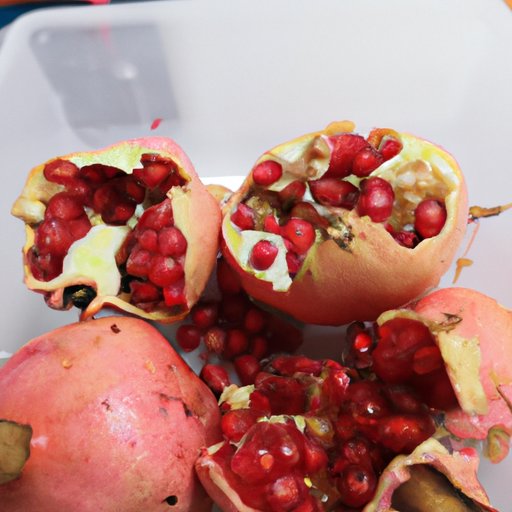Introduction
Pomegranates have been enjoyed as a nutritious and delicious food for centuries. They are an antioxidant-rich fruit that is packed with vitamins and minerals, making them a great addition to any diet. In this article, we’ll explore how to eat pomegranates, the many health benefits associated with consuming them, and some creative and delicious recipes that you can make with pomegranates.
What is a Pomegranate?
A pomegranate is a large, round or oblong-shaped fruit with a leathery outer skin. Inside, it contains hundreds of edible seeds surrounded by a juicy, tart flesh. The seeds are often referred to as arils, and they have a sweet-tart flavor. Pomegranates are usually red or purple in color, but there are also white varieties available. Pomegranates are native to the Middle East, but they are now grown in many parts of the world.
Why Eat Pomegranates?
Pomegranates are a nutrient-dense food, meaning that they are high in vitamins, minerals, and other beneficial compounds. They are also low in calories and fat, making them a great choice for those looking to lose weight or maintain a healthy weight. Studies have shown that pomegranates may have a number of potential health benefits, including reduced risk of heart disease, improved cholesterol levels, and lower blood pressure. In addition, pomegranates are a good source of fiber, which can help promote regularity and keep you feeling full for longer.
Step-by-Step Guide to Eating Pomegranates
If you’ve never eaten a pomegranate before, don’t worry—it’s easy! Here are some simple steps to help you get started.
How to Cut and Prepare a Pomegranate for Eating
1. Cut off the top of the pomegranate with a sharp knife. Make sure to cut far enough down to expose the seeds inside.
2. Score the sides of the pomegranate several times with the knife. This will make it easier to remove the seeds.
3. Gently pull apart the pomegranate into sections. You should see the individual seeds inside.
4. Place the pomegranate into a bowl of cold water. This will make it easier to remove the seeds without making a mess.
5. Gently remove the seeds from the pomegranate using your hands. The seeds will sink to the bottom of the bowl while the pulp and membranes will float to the top.
6. Strain out the seeds and discard the pulp and membranes.
Tips for Eating Pomegranates with Maximum Enjoyment
1. Use fresh pomegranates whenever possible. Fresh pomegranates have the best flavor and texture.
2. If you’re not eating the pomegranate right away, store it in the refrigerator. This will help to preserve its freshness and prevent it from going bad.
3. Sprinkle the pomegranate seeds over salads, oatmeal, yogurt, or desserts for added flavor and texture.
4. If you don’t want to bother with removing the seeds, try adding pomegranate juice to smoothies or cocktails for a refreshing twist.

Health Benefits of Eating Pomegranates
Nutritional Value of Pomegranates
Pomegranates are a great source of vitamins, minerals, and other beneficial compounds. They contain vitamin C, B vitamins, potassium, magnesium, and phosphorus. In addition, pomegranates are a good source of dietary fiber, which can help promote regularity and keep you feeling full for longer.
Potential Health Benefits of Eating Pomegranates
Studies have suggested that pomegranates may have a number of potential health benefits. Some research has found that pomegranates may help reduce the risk of heart disease, improve cholesterol levels, and lower blood pressure. In addition, pomegranates are high in antioxidants, which can help protect the body from damage caused by free radicals.
10 Delicious Recipes Using Pomegranates
Pomegranates are a versatile fruit that can be used in a variety of dishes. Here are 10 delicious recipes that use pomegranates in creative and tasty ways.
Breakfast Ideas
1. Pomegranate Overnight Oats
2. Pomegranate Coconut Chia Pudding
3. Pomegranate Acai Bowl
4. Pomegranate Banana Smoothie
Lunch and Dinner Ideas
1. Pomegranate Quinoa Salad
2. Roasted Beet and Pomegranate Salad
3. Pomegranate Glazed Salmon
4. Pomegranate Chicken Skewers
Desserts and Snacks
1. Pomegranate Cheesecake
2. Pomegranate Chocolate Bark
3. Pomegranate Fudge
4. Pomegranate Yogurt Parfait

Creative Ways to Incorporate Pomegranates into Your Diet
Salads and Sides
1. Add pomegranate seeds to green salads for a burst of color and flavor.
2. Use pomegranate molasses to dress roasted vegetables.
3. Top cooked grains such as quinoa or couscous with a sprinkle of pomegranate seeds.
Appetizers and Drinks
1. Make a pomegranate margarita or martini for a festive cocktail.
2. Serve pomegranate salsa with chips as a flavorful appetizer.
3. Mix pomegranate juice with sparkling water for a refreshing drink.
Conclusion
Summary of Benefits of Eating Pomegranates
Pomegranates are a nutrient-dense, antioxidant-rich food that can be enjoyed in a variety of ways. Eating pomegranates may offer a number of potential health benefits, including reduced risk of heart disease, improved cholesterol levels, and lower blood pressure. In addition, pomegranates are a good source of dietary fiber, which can help promote regularity and keep you feeling full for longer.
Final Thoughts on Eating Pomegranates
Eating pomegranates is a delicious and nutritious way to add variety to your diet. Whether you choose to enjoy them fresh, juiced, or cooked, pomegranates are a great way to get more of the vitamins, minerals, and other beneficial compounds that your body needs.
(Note: Is this article not meeting your expectations? Do you have knowledge or insights to share? Unlock new opportunities and expand your reach by joining our authors team. Click Registration to join us and share your expertise with our readers.)
